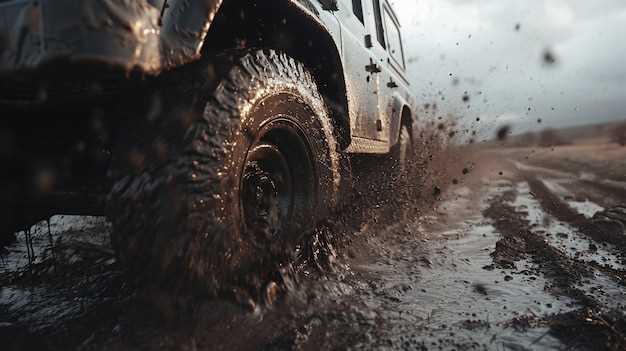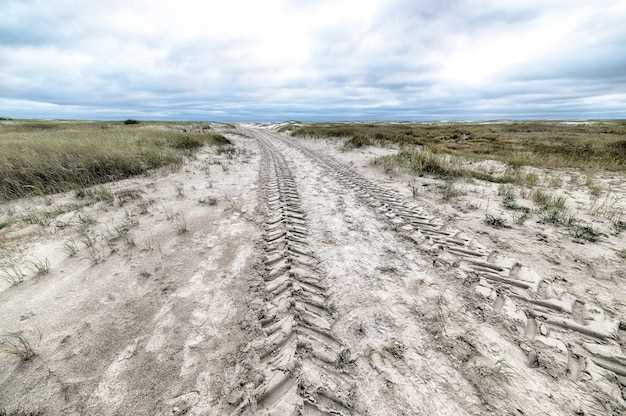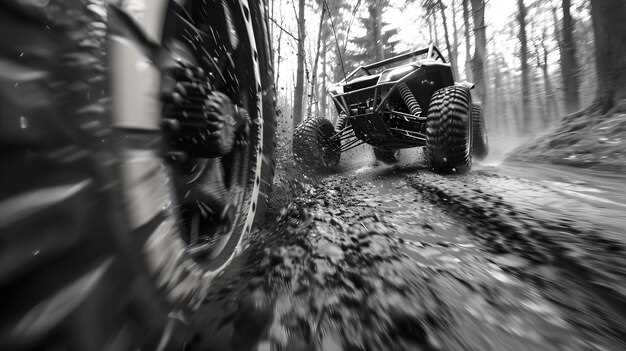
When it comes to off-roading, having the right tires is crucial for achieving optimal performance and safety. The selection of tires can significantly influence your vehicle’s traction on various terrains such as mud, sand, and rocky landscapes. Each environment presents unique challenges that require specialized tire features to ensure your vehicle remains stable and capable of overcoming obstacles.
In muddy conditions, for instance, tires with aggressive tread patterns and wide voids are essential for channeling water away and preventing slippage. Conversely, sand demands lighter, wider tires designed to float over the surface without getting bogged down. When navigating rocky terrain, durable sidewalls and robust tread designs are critical for providing the necessary grip and protection against punctures.
This article will delve into the best off-road tires specifically engineered for these diverse conditions. By examining key characteristics that enhance traction, we will guide you in making an informed choice that aligns with your off-road adventures and pursuits.
Best Off-Road Tires for Mud, Sand, and Rocks

When it comes to conquering challenging terrains like mud, sand, and rocky surfaces, choosing the right off-road tires is crucial for maximizing traction and ensuring a safe driving experience. The ideal tires must have specific features tailored for these diverse conditions.
For muddy paths, tires should possess deep, aggressive tread patterns that efficiently channel water away, preventing hydroplaning and allowing the vehicle to maintain grip. Models such as the BFGoodrich Mud-Terrain T/A KM3 are designed for such environments, featuring large, self-cleaning lugs that provide excellent traction in slippery conditions.
In sandy terrains, lighter tires with a wider footprint are beneficial. They help distribute the weight of the vehicle, reducing sinking and enhancing mobility. The Goodyear Wrangler MTR with Kevlar is a solid choice, as it offers sidewall protection while maintaining flexibility and grip in soft sand.
When navigating rocky landscapes, durability and sidewall strength are paramount. Tires like the Nitto Trail Grappler M/T combine robust construction with a tread design that allows for enhanced traction over sharp surfaces. This ensures that the tires can withstand punctures and provide reliable grip on uneven terrain.
Ultimately, selecting the right off-road tires for mud, sand, and rocks is essential for achieving optimal traction and performance. Consider your specific driving conditions and vehicle requirements to ensure the best choice for your adventures.
Understanding Tire Tread Patterns for Optimal Traction
Choosing the right tires for off-road conditions is crucial for achieving optimal traction. The tread pattern of a tire significantly influences its performance in mud, sand, and rocky terrains. Different designs cater to specific driving environments, ensuring that your vehicle maintains grip and stability.
Here are some common tire tread patterns and their advantages for various off-road situations:
- Aggressive Tread:
- Large, deep lugs that dig into soft surfaces such as mud and sand.
- Helps to prevent slippage and enhances forward momentum.
- All-Terrain Tread:
- Moderate tread depth suitable for a combination of off-road and on-road conditions.
- Features a dual-purpose design for balanced traction across a variety of surfaces.
- HT (Highway Terrain) Tread:
- Shallower grooves designed for improved handling and decreased road noise.
- More suited for loose surfaces but can struggle in extreme off-road conditions.
- Mud Tires:
- Specialized lugs that channel mud away from the tire, enhancing grip.
- Ideal for muddy or swampy terrains where deep traction is required.
- Sand Tires:
- Wide, paddle-like treads designed to provide floatation over soft sand.
- Minimizes sinking and maximizes traction when moving through dunes.
- Rock Crawling Tires:
- Designed with a sticky rubber compound and unique tread patterns for grip on rocky surfaces.
- Features reinforced sidewalls for added protection against cuts and punctures.
When selecting off-road tires, consider the specific characteristics of your intended environment. Examine how the tread design aligns with your needs for traction, stability, and durability. Understanding tire tread patterns will enable you to make an informed choice, enhancing your off-road driving experience.
Choosing the Right Tire Size for Your Off-Road Vehicle
Selecting the appropriate tire size is crucial for maximizing the performance of your off-road vehicle. Tires play a pivotal role in traction, stability, and overall handling, particularly on challenging terrains like mud, sand, and rocks.
Understand Your Vehicle’s Specifications: Begin by consulting your vehicle’s manufacturer guidelines to identify the recommended tire sizes. This ensures compatibility with your vehicle’s setup, including suspension, gearing, and body clearance.
Consider Your Terrain: Different off-road conditions require specific tire attributes. For muddy environments, wider tires are beneficial as they provide better flotation and prevent sinking. In sandy terrains, larger tires improve surface contact and help maintain momentum. Conversely, for rocky trails, tires with reinforced sidewalls and a smaller profile can enhance durability and reduce the risk of punctures.
Tire Diameter and Width: Increasing the diameter of your tires can improve ground clearance but may affect your vehicle’s gearing and handling. Taller tires can provide better obstacle clearance but require careful consideration to avoid interference with body parts. The width of the tires also impacts traction; wider tires spread the vehicle’s weight, reducing ground pressure and enhancing grip.
Aspect Ratio: The aspect ratio, which is the height of the tire sidewall compared to its width, influences ride comfort and performance. A lower aspect ratio on off-road tires typically enhances responsiveness, while a higher ratio offers better cushioning on rocky terrains.
Test and Evaluate: Finally, after selecting a tire size that meets your needs, consider conducting a test drive in the conditions you intend to encounter. This allows you to assess tire performance and make adjustments if necessary.
Choosing the right tire size for your off-road vehicle goes beyond basic measurements; it requires understanding the dynamic interplay between your tires, vehicle capabilities, and the challenges of the terrains you will tackle. Make informed decisions to enhance your off-road adventures.
Top Brands for Off-Road Tires: A Comparative Analysis
When selecting off-road tires, understanding the various brands is crucial for making an informed decision. Different manufacturers provide unique features tailored for specific terrains like mud, sand, and rocks. Below is a comparative analysis of some top brands known for their off-road tires.
1. BFGoodrich: Renowned for producing durable and high-performance tires, BFGoodrich offers several models specifically designed for off-road conditions. Their All-Terrain T/A KO2 stands out for its excellent grip in mud and sand, while maintaining structural integrity on rocky terrains. The brand’s extensive racing background contributes to its reputation for performance and reliability.
2. Goodyear: As a long-established tire manufacturer, Goodyear provides a diverse range of off-road tires. The Wrangler MT/R with Kevlar is designed for maximum traction in the harshest environments. This tire is praised for its sidewall durability and self-cleaning capabilities, making it an excellent choice for muddy trails.
3. Nitto: Nitto has gained popularity among off-road enthusiasts for its innovative tread designs. The Tera Grappler G2 is particularly notable for its balanced performance on and off the road. It offers decent traction in various conditions, making it versatile enough for drivers looking to tackle mud, sand, and rocky paths without frequent tire changes.
4. Michelin: While Michelin is often associated with road tires, they also produce high-quality off-road options. The Baja Champion tire is aimed at competitive off-road racing and is designed to handle abusive terrains. Its lightweight construction and aggressive tread pattern make it an exceptional choice for serious off-road enthusiasts.
5. Falken: Falken tires have made a strong impression in the off-road market with models like the Wildpeak AT3W. This tire is built for all-terrain conditions, offering excellent traction and stability in various environments, including mud and gravel. Falken focuses on providing a balance between on-road comfort and off-road capabilities.
Choosing the right off-road tires involves evaluating specific tire features and brand reliability. Brands like BFGoodrich, Goodyear, Nitto, Michelin, and Falken present unique options suitable for diverse off-road challenges, ensuring that off-road enthusiasts have quality choices to optimize their experience on rugged terrains.
Maintenance Tips for Prolonging Tire Life in Harsh Conditions
Ensuring the longevity of off-road tires, especially in challenging environments like mud, sand, and rocky terrains, requires consistent maintenance. Here are some essential tips to enhance traction and extend the lifespan of your tires:
- Regular Inspection
- Check for visible damage such as cuts, punctures, or cracks that can compromise tire integrity.
- Monitor tread depth to ensure optimal traction and performance; replace tires when tread is worn out.
- Proper Inflation
- Maintain the appropriate tire pressure based on manufacturer recommendations for off-road conditions.
- Under-inflated tires can increase the risk of sidewall damage, while over-inflated tires can reduce traction.
- Cleaning Tires After Use
- Remove mud, sand, and debris after off-road excursions to prevent damage and maintain performance.
- Use a pressure washer or hose to clean tread patterns, ensuring that traction is not compromised.
- Regular Rotation
- Rotate your tires every 5,000 to 7,500 miles to promote even wear, which can improve traction in off-road conditions.
- Follow the vehicle manufacturer’s guidelines for rotation patterns.
- Avoid Excessive Speed
- Excessive speed can lead to overheating and rapid wear, especially in rough terrains where traction is paramount.
- Drive at moderate speeds to enhance control and prevent tire damage.
- Choose the Right Tire for Conditions
- Select tires specifically designed for off-road conditions if you frequently navigate through mud, sand, and rocks.
- Invest in high-quality tires that provide optimal traction and durability suited for aggressive terrains.
By implementing these maintenance strategies, you can significantly enhance the performance and lifespan of your off-road tires in harsh conditions, ensuring you get the best traction when it matters most.
How to Properly Inflate Off-Road Tires for Different Terrains
Proper tire inflation is crucial for maximizing the performance of off-road tires in various terrains such as mud, sand, and rocks. The right pressure can significantly enhance traction, stability, and overall vehicle handling. It’s essential to adjust the tire pressure based on the specific conditions you’ll encounter. Below is a guide on how to properly inflate off-road tires for these different terrains.
| Terrain Type | Optimal Tire Pressure (PSI) | Notes |
|---|---|---|
| Mud | 10-15 PSI | Lower pressure improves tire footprint, enhancing grip. Be cautious of pinch flats. |
| Sand | 12-18 PSI | Reducing pressure prevents tires from sinking. Adjust based on sand consistency. |
| Rocks | 15-20 PSI | Higher pressure aids in avoiding sidewall damage while maintaining stability. |
When inflating off-road tires, it’s important to use a reliable air compressor and a pressure gauge to ensure accuracy. Always check tire pressure before hitting the trail, as temperature changes can affect PSI readings. After your off-road adventure, re-inflate your tires back to the manufacturer’s recommended pressure for regular driving conditions.
In conclusion, adjusting your off-road tires’ inflation levels based on the terrain is vital for optimal performance and safety. Understanding the right pressure for mud, sand, and rocks can make a significant difference in your off-roading experience.
User Reviews and Real-World Performance of Popular Off-Road Tires

When it comes to off-road adventures, user reviews provide invaluable insights into the performance of various tires across different terrains. One of the most critical aspects that drivers focus on is traction. Off-road tires are designed to perform optimally in mud, sand, and rocky environments, and real-world experiences can often highlight their strengths and weaknesses.
Many users commend the BFGoodrich All-Terrain T/A KO2 for its versatile off-road capabilities. Reviewers note that this tire excels in muddy conditions, thanks to its aggressive tread pattern that channels water effectively, preventing hydroplaning and allowing for better grip. Users who traverse rocky landscapes also appreciate the KO2 for its durability, which helps to withstand impacts from sharp stones.
The Goodyear Wrangler MT/R is another tire frequently mentioned for its excellent traction in extreme conditions. Off-road enthusiasts share stories of conquering deep mud and loose sand with this tire, claiming that its self-cleaning design ensures consistent performance. However, some users advise caution in on-road conditions, where the noise levels can be higher compared to all-terrain variants.
In contrast, the Falken Wildpeak MT receives praise for its adaptability. Many drivers report exceptional performance not only in mud but also on rocky trails. Users indicate that the Wildpeak MT provides a comfortable ride while maintaining necessary traction on steep inclines and descents. Some have even tested it in sand and found its performance to exceed expectations–proving its versatility across various terrains.
Lastly, the Nitto Trail Grappler is often highlighted for its rugged design and strong off-road performance. User feedback suggests that it performs admirably in both mud and sand, with substantial gripping capabilities. However, several reviewers caution that it may wear more quickly on paved roads, urging potential buyers to consider their driving habits before making a selection.
Overall, user reviews reaffirm that choosing the right off-road tire hinges on understanding specific needs and driving conditions. Each tire has its unique strengths that cater to different terrains, making it essential for drivers to evaluate their typical off-road scenarios when selecting the best option for traction.




